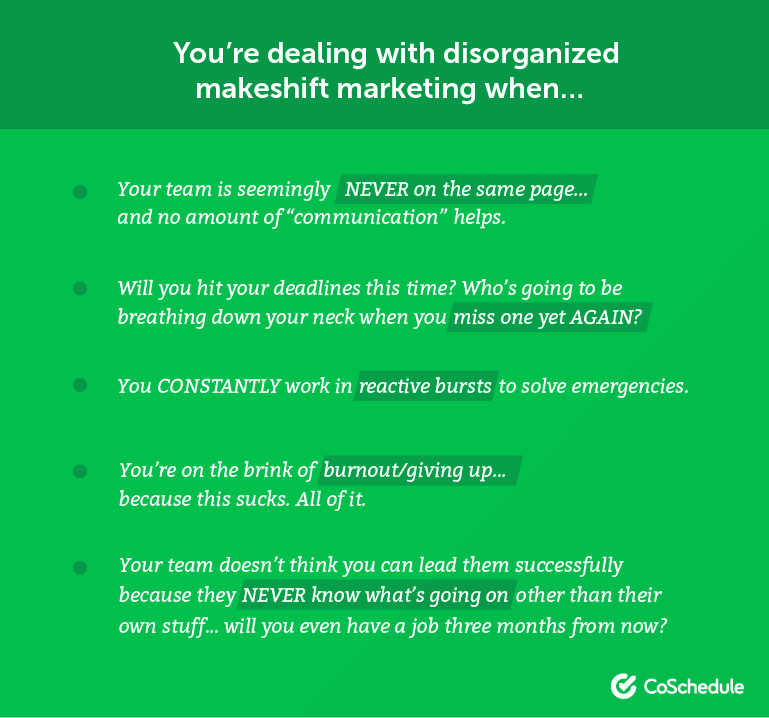How To Prove The ROI Of Getting Organized [Backed By Science]
 Here are three facts I know to be 100% certain:
Here are three facts I know to be 100% certain:
- Marketers who document their plan are 538% more successful than those who don’t.
- Marketers who document their processes are 466% more successful than those who don’t.
- Marketers who set goals are 429% more successful than those who don’t.
- You need to prove to your boss that it’s worth your time and investment to implement new tools and processes to get organized.
- Your team needs some reassurance that while change is difficult, that after implementing new organizational procedures that their lives will actually be way easier—proven by science.
- You need a kick in the pants to get organized now… because every day you spend frustrated by disorganization is another wasted opportunity.
How To Prove The ROI Of Getting Organized (Backed By Science)
Click To TweetYou Literally Don’t Have To Work As Hard When You’re Organized (This Is A Really Good Thing)
Disorganization in your marketing operations causes extreme frustration. Frustration is a feeling of anger or annoyance caused by being unable to do something, according to Merriam-Webster dictionary.
I thought it was interesting to read the example sentence Merriam-Webster used to define frustration because it applies all too well to the topic of disorganized marketing:
These bureaucratic delays have been causing us a lot of frustration.
Hm. ^^^ I’m sure you’ve been there.
A study from the US National Library of Medicine National Institutes of Health aimed to understand how frustration impacted brain activity while participants executed tasks they knew really well.
The result?
It takes increased attentional effort to complete well-learnt tasks when you’re frustrated.
Therefore, if being disorganized causes you to feel frustrated, you’re likely to experience more stress and expend more mental energy to complete your work.
In short, you have to work harder when you’re frustrated. It slows you down, shatters productivity, and destroys your efficiency.
Frustration is a feeling of anger or annoyance caused by being unable to do something, according to Merriam-Webster dictionary.
I thought it was interesting to read the example sentence Merriam-Webster used to define frustration because it applies all too well to the topic of disorganized marketing:
These bureaucratic delays have been causing us a lot of frustration.
Hm. ^^^ I’m sure you’ve been there.
A study from the US National Library of Medicine National Institutes of Health aimed to understand how frustration impacted brain activity while participants executed tasks they knew really well.
The result?
It takes increased attentional effort to complete well-learnt tasks when you’re frustrated.
Therefore, if being disorganized causes you to feel frustrated, you’re likely to experience more stress and expend more mental energy to complete your work.
In short, you have to work harder when you’re frustrated. It slows you down, shatters productivity, and destroys your efficiency.

Science Proves That Setting Deadlines Helps You Actually Complete Tasks On Time
Deadline is a date or time before which something must be done, again, according to Merriam-Webster dictionary. Researchers at MIT conducted a study on procrastination, deadlines, and precommitment. Essentially, they wanted to know if incremental deadlines would help projects be completed on time rather than at the last minute (or not at all). That study found self-imposed deadlines aren’t as effective as externally-imposed, evenly-spaced deadlines. So. People are scientifically proven to be more effective when larger “projects” are broken down and assigned to them as deadlines over time. ^^^ Yep. People work better when they’re told what to do and when to have it done.
So… to summarize… psychology suggests:
Being organized enough to plan your workflows and delegate task deadlines will help you complete projects on time.
^^^ Yep. People work better when they’re told what to do and when to have it done.
So… to summarize… psychology suggests:
Being organized enough to plan your workflows and delegate task deadlines will help you complete projects on time.
Being organized enough to plan your workflows and delegate task deadlines will help you complete projects on time.
Click To Tweet- Break down all of the work to be done for a piece of content in a chronological list. For example, consider everything you need to do to plan, write, and publish a white paper from beginning to end.
- Eliminate all unnecessary tasks from the list. Andrew S. Grove, former CEO at Intel, suggests targeting a specific number of tasks to remove from your workflow can help you reduce your workload by 30-50%. Remove tasks that fall into other workflows, exist for bureaucratic/approval purposes, and are outdated.
- Decide who will complete each of those tasks. You’re thinking of one name per task here—because the moment you delegate one task to two people is the moment each points fingers at the other to complete the work (or… push blame on the other when the work never gets completed).
- Figure out when the last task in the workflow needs to be done. In marketing lingo, you can think of this as # of days before publish. For example, if you need a blog post to be 100% complete two weeks before it publishes, the last task in the workflow needs to be done 14 days before the publish date. Now you know the second-to-last task needs to be completed 15 days before publish, the third-to-last task 16 days before publish, and all the way up the list to the very first task so you’ll know exactly when to begin the workflow.
- The workflow for a specific piece of content so no detail gets missed.
- Accountability for each task within the workflow so you can efficiently assign the work among your team.
- When every task needs to be completed so, as a collective project, the content is completed on time, thereby crushing your deadline.
If You’re Persistent, You’ll Get It. If You’re Consistent, You’ll Keep It.
Tony Robbins once said… It’s not what we do once in a while that shapes our lives. It’s what we do consistently.It’s not what we do once in a while that shapes our lives. It’s what we do consistently.
Click To Tweet[…] commitment alone […] and commitment plus another treatment (e.g., feedback, incentives, persuasive messages, […]) were significantly more effective than control groups.That means if you commit to something, you’re likely to be successful at it. Go figure. And, that means if you commit to something AND communicate during that commitment, you’re even more likely to be successful. Consider that when you make a behavioral change in your marketing team… The study goes on to elaborate:
[…] both commitment only and commitment plus another treatment yielded sustained behavior change.That means commitment leads to long-term behavior change, therefore, long-term success. So. If you’re persistent right away, you’ll get it. If you’re consistent with that commitment, you’ll keep it.
 As a marketer, you likely hear all too often that “Consistency is key to success!”
Well, for you to get organized personally, science proves that’s true.
And, as far as your marketing’s results go, consistency is a major driver of success, too.
Consider this…
As a marketer, you likely hear all too often that “Consistency is key to success!”
Well, for you to get organized personally, science proves that’s true.
And, as far as your marketing’s results go, consistency is a major driver of success, too.
Consider this…
- A website with zero pages will get zero visitors. That means zero page views, zero email subscribers, and… zero customers.
- A website with a couple pages may get visitors. That means a few page views, a couple subscribers, and maybe some customers.
- A website with 10 thousand pages will get thousands of visitors, thousands of email subscribers, and hundreds of customers.
 CoSchedule launched September 23, 2013. A big spike! Followed by actual days of zero page views. wah-wah
This is CoSchedule’s traffic recently:
CoSchedule launched September 23, 2013. A big spike! Followed by actual days of zero page views. wah-wah
This is CoSchedule’s traffic recently:
 That didn’t happen over night.
A commitment to publishing at least two blog posts every single week since 2013 gave us:
That didn’t happen over night.
A commitment to publishing at least two blog posts every single week since 2013 gave us:
- Opportunities to test various topics and angles to understand what our audience would be interested in.
- The option of failure. It’s not possible for every piece to be a winner. But that gave us so many ways to learn what not to do, so we could improve everything we should do moving forward.
- Thousands of keywords to rank on. When every blog post targets a keyword, every search brings new traffic. Organic search accounts for 69% of our traffic, which wouldn’t be possible if we didn’t consistently publish content strategically targeted at ranking for terms our audience uses.
 It’s not easy. I fully remember late nights on Sundays and Tuesdays to make damn sure we published first thing Monday and Wednesday mornings. We were committed. It had to happen no matter what.
But.
We got better at it.
Getting organized, creating workflows, and setting goals helped us commit to producing content that produces results.
It’s not easy. I fully remember late nights on Sundays and Tuesdays to make damn sure we published first thing Monday and Wednesday mornings. We were committed. It had to happen no matter what.
But.
We got better at it.
Getting organized, creating workflows, and setting goals helped us commit to producing content that produces results.
What Is Being Organized Worth To You?
Just by running through the frameworks with the examples in this article, being organized would:- Give you 6 hours of productivity and save $180 on every white paper you’d produce moving forward.
- Free up 3 hours of productivity and save $90 on every blog post you’ll write in the future.
- Boost your recurring monthly pageviews by 8,000.
Here's data-backed proof that getting organized delivers measurable marketing ROI
Click To Tweet

